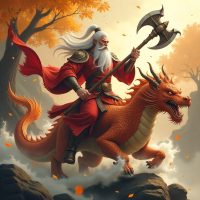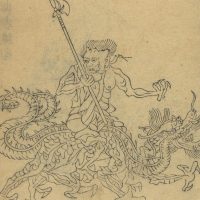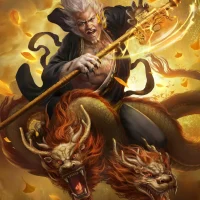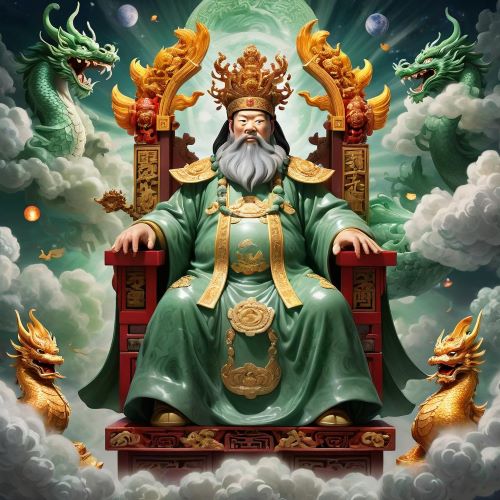Ru Shou : The Autumn Enforcer of Ancient Chinese Lore
Listen
At a glance
| Description | |
|---|---|
| Origin | Chinese Mythology |
| Classification | Gods |
| Family Members | N/A |
| Region | China |
| Associated With | Metal, Autumn |
Ru Shou
Introduction
Ru Shou, also known as Rushou (蓐收), is one of the most striking figures in classical Chinese mythology, representing the season of autumn, the element of metal, and the western direction within the cosmological system of the Five Phases (Wu Xing). Unlike benevolent deities associated with creation or fortune, Ru Shou embodies contraction, decline, judgment, and the inevitable close of cycles. His role bridges natural transformation with moral order, making him both a cosmic regulator and a divine enforcer. Although he is not as widely recognized as the Jade Emperor or the Yellow Emperor, Ru Shou’s presence in ancient texts highlights his vital function in maintaining balance between life, death, punishment, and renewal. Through these attributes, he stands as a deity whose influence extends far beyond seasonal symbolism, echoing themes of justice and cosmic discipline.
Physical Traits
Descriptions of Ru Shou emphasize a hybrid form designed to convey authority, vigilance, and fierce discipline. Traditional accounts depict him with the face of a human yet covered in white fur, symbolizing both purity and the coldness of autumn. His hands transform into sharp tiger claws, connecting him to the White Tiger (Baihu), the celestial beast that governs the west and the metal element. This imagery underscores Ru Shou’s ferocity and his dominion over retribution.
A serpent hangs from his left ear, an unusual yet meaningful detail that highlights danger, alertness, and the thin line between life and death. He wields a heavy battle-axe, the primary emblem of his role as a cosmic executioner responsible for cutting away excess and enforcing moral correction. His mount—two divine dragons—signifies not only his high celestial rank but also his command over the forces that regulate the universe. Each aspect of his appearance reinforces his purpose: to usher in endings, deliver justice, and balance the natural order.
Family
Ru Shou’s genealogical background varies across mythological traditions, reflecting the fluidity of ancient Chinese narratives. In many accounts, he is closely associated with Shaohao, the deity of the west and patron of the metal element. Some texts describe Ru Shou as Shaohao’s assistant, working to oversee the western regions of the cosmos. Other traditions elevate him further, placing him as Shaohao’s son or relative, thereby securing his authority within the pantheon.
In alternative genealogical lines, Ru Shou is linked to descendants of the Yellow Emperor (Huangdi), which aligns him with the legendary rulers who structured early Chinese culture and order. Regardless of the version, Ru Shou’s family associations always reinforce his legitimacy as the divine agent of punishment and seasonal transition. His lineage places him firmly within the systems that govern cosmic stability.
Other names
Ru Shou is known by several names that emphasize different aspects of his identity. His original name, 蓐收 (Rushou), is usually translated as “harvest gatherer,” directly connecting him with autumn’s primary agricultural role—the season of collecting and closing cycles. In various texts, he is referred to as the God of Autumn, Autumnal Judge, or God of the West, each title emphasizing the domain for which he is responsible.
Some interpretations also label him the God of Metal, because he governs the metal phase in Wu Xing, representing strength, discipline, and the final stage before dissolution. These alternative names help deepen the understanding of his multifaceted purpose, ranging from agricultural symbolism to cosmic justice and directional governance.
Powers and Abilities
Ru Shou’s abilities reflect the sharp, contracting force of autumn and the inherent qualities of metal—strength, precision, and decisiveness. As the deity who governs the west and the decline of the yearly cycle, he is responsible for the falling of leaves, the end of growth, and the preparation of nature for winter’s stillness. This power is not destructive for its own sake but is essential for the renewal that follows.
In myth, Ru Shou is also the executor of divine punishment. He is known for appearing in dreams or visions to warn individuals of moral transgression. The story of Duke Guo is a notable example: Ru Shou’s warning went unheeded, ultimately leading to the downfall of the duke’s state. This tale illustrates his role not only as a punisher but also as a herald of impending justice, allowing mortals the opportunity to change their fate.
His battle-axe symbolizes his authority to cut away corruption, while his association with the White Tiger further highlights his responsibility for cosmic discipline. Through these roles, Ru Shou represents the idea that justice, like the seasons, is cyclical and unavoidable.
Modern Day Influence
Although Ru Shou is not widely worshipped in contemporary China, his symbolism persists in cultural thought, literature, and seasonal understanding. The association of autumn with reflection, accountability, and endings stems partly from the worldview shaped by deities like Ru Shou. In feng shui and traditional Chinese medicine, the metal element continues to represent clarity, structure, and righteousness—values strongly linked to Ru Shou’s mythic essence.
In popular culture, Ru Shou occasionally appears in video games, fantasy novels, and digital art inspired by Chinese mythology. Games such as Age of Mythology: Retold feature characters based on Ru Shou, often emphasizing his martial and seasonal powers. Scholars and enthusiasts exploring the Five Phases system frequently reference Ru Shou when examining cosmological cycles and ancient Chinese moral philosophy.
His enduring presence reflects a broader cultural truth: the principles he represents—order, justice, endings, and renewal—remain deeply woven into the Chinese understanding of life and the universe.
Related Images
Source
Wikipedia contributors. (2025, February 22). Rushou. Wikipedia. https://en.wikipedia.org/wiki/Rushou
Age of Empires Series Wiki. (2025, September 16). Rushou. Fandom. https://ageofempires.fandom.com/wiki/Rushou
China Beasts and Legends. Ru Shou 蓐收 (rù shōu). https://www.chinabeastsandlegends.com/ru-shou
China Knowledge. (n.d.). Ru Shou 蓐收. http://www.chinaknowledge.de/History/Myth/personsrushou.html
TheGamer. (2025, March 20). Every Chinese God, Ranked in Age Of Mythology: Retold. https://www.thegamer.com/age-of-mythology-retold-every-chinese-god-ranked/
Divineverse Wiki. (2007, December 31). Rushou. https://divineverse.fandom.com/wiki/Rushou
Frequently Asked Questions
Who is Ru Shou in Chinese mythology?
Ru Shou is the Chinese god of autumn, metal, the west, and divine punishment within the Five Phases cosmological system.
What does Ru Shou look like?
He is described with a human face covered in white fur, tiger claws, a serpent on his left ear, and a battle-axe, often riding on two dragons.
What powers does Ru Shou have?
Ru Shou controls autumnal forces, metal energy, and divine retribution, delivering justice and endings in the cosmic cycle.
Is Ru Shou related to the White Tiger?
Yes. Ru Shou’s tiger-like features and western alignment connect him to the White Tiger, the celestial beast of the West.
Does Ru Shou appear in modern culture?
He appears in mythology-based games, literature, and modern discussions about cosmology and the Five Phases.











